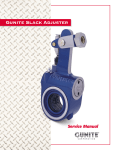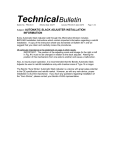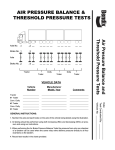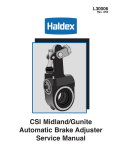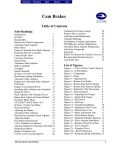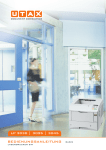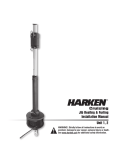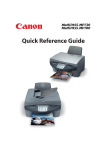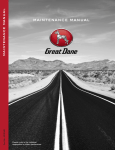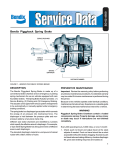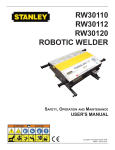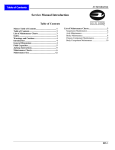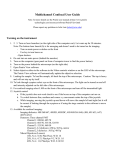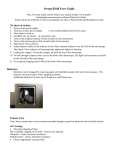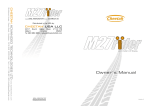Download L31171 Rev. 11/05 - WMFleetParts.com
Transcript
L31171 Rev. 11/05 Sealed Spring Brakes Life Seal®, Gold Seal® and Midland Installation Instructions Contents GENERAL SAFETY PRECAUTIONS ..................................2-5 SPRING BRAKE DISARMING PROCEDURES ...................20 RECOMMENDED PREVENTATIVE MAINTENANCE ............6 ORANGE ALERT STROKE INDICATOR OPERATION........21 GOLD SEAL/MIDLAND - MECHANICAL RELEASE OF SPRING BRAKE ...................................................................7-9 DETERMINING WARRANTY STATUS .................................22 LIFE SEAL - MECHANICAL RELEASE OF SPRING BRAKE....................................................................................10 SEALED INSTALLATION INSTRUCTIONS COMBINATION SPRING BRAKES ..................................11-15 PIGGYBACK MODEL ......................................................16, 17 ROTATING MOUNTING BOLTS, CLAMPS AND AIR PORTS....................................................................18 SERVICE DIAPHRAGM REPLACEMENT............................19 Throughout this manual, you will notice the terms “NOTE”, “IMPORTANT”, “WARNING”, and “DANGER” followed by important product information. So that you may better understand the manual, those terms are defined below. The warns of the possibility of personal injury or death. NOTE: Is used as a reminder of an instruction where the concern deals with product integrity and has to do with installation, operation, maintenance or service and care of the product. IMPORTANT: Used without the safety alert symbol, is used as a reminder of an instruction where the concerns deal with product integrity and have to do with installation, operation, maintenance or service and care of the product. It is intended to show that vehicle breakdown and/or expensive repair could result if the instruction is not followed. WARNING: Is used with an instruction for the purpose of showing that a safe practice must be adhered to or that an unsafe practice must be avoided, and that if proper precautions are not taken, personal injury could result. DANGER: Indicates a potentially hazardous situation which, if not avoided, may result in serious injury or death. 2 General Safety Precautions FIG 1 - Gold Seal/Midland Spring Brake DANGER: A spring brake contains a very powerful compression spring. Failure to comply with all of the following instructions may result in forceful release of the piggyback or spring chamber and its contents which could CAUSE DEATH, SEVERE PERSONAL INJURY AND/OR PROPERTY DAMAGE. IMPORTANT: ALWAYS BLOCK WHEELS to prevent vehicle rollaway when performing any brake maintenance. TETHERED DUST PLUG POCKET FOR RELEASE TOOL PERMANENTLY SEALED CHAMBER CAUTION: DO NOT ATTEMPT TO DISASSEMBLE DANGER: Haldex DOES NOT recommend the rebuilding of any of its air brake actuator products. Nor does Haldex recommend the use of rebuilt Haldex air brake actuators. • If spring brake shows structural damage DO NOT cage the spring and DO NOT attempt to service it. Replace the complete unit. To prevent severe personal injury when removing an uncaged spring brake from a vehicle, cut the service push rod making sure to relieve all force on it. After cutting the push rod, remove the spring brake from the vehicle, then disarm the spring brake using a suitable safety chamber (See Page 20 Figure 36). • Never strike any part of the spring brake with a hammer or any other heavy object; structural damage may result. • Do not drop spring brake, as power spring may forcefully release. • If air pressure is used to aid in the caging process, do not tighten the release tool more than finger tight. The air pressure must always be exhausted after the spring has been mechanically caged prior to any disassembly. FIG 2 - Life Seal Spring Brake INTEGRAL RELEASE TOOL -NO SIDE POCKET PERMANENTLY SEALED CHAMBER CAUTION: DO NOT ATTEMPT TO DISASSEMBLE • On all Haldex Life Seal, Gold Seal and Midland Spring Brakes, the emergency diaphragm cannot be replaced. Replace the complete piggyback. (Follow instructions listed under “Mechanical Release” on Page 7-9 for Gold Seal/Midland brakes. Page 10 for Life Seal brakes. And “Piggyback Installation Instructions” on Pages 16 and 17). IMPORTANT: It is recommended that a new service brake diaphragm be used when installing a new piggyback. DO NOT use a piloted diaphragm on the service side (a piloted “protrusion” diaphragm is designed to be used in the emergency spring chamber only). Use of a piloted diaphragm results in a reduction of stroke length. Continued on next page 3 General Safety Precautions • Haldex manufactures a complete line of 3.0" (76mm) stroke brake actuators. In some cases these are referred to as “Long Stroke” (L). In other cases they are referred to as “Extra Long Stroke” (XL). To avoid confusion, please refer to Table 1 below. TABLE 1 STROKE MODELS 2.5" (64MM) STROKE MODELS 3.0" (76MM) STROKE MODELS COMBINATION PIGGYBACK COMBINATION PIGGYBACK GC2424L GC2430L LC2430 GC3030 GC3036 LC3030 GP2424L GP2430L LP2430 GP3030 GP3036 LP3030 GC2430XL LC2430L GC3030L LC3030L GP2430XL LP2430L GP3030L LP3030L WARNING: NEVER interchange 3.0" (76mm) stroke actuator components with 2.25" (57mm) or 2.5" (64mm) stroke components. Performance and stroke may be seriously affected. WARNING: NEVER interchange spring brake manufacturers components. Performance and stroke may be seriously affected. Although spring brake manufacturers components look similar, they should never be interchanged. • When servicing 3.0” stroke actuators, it is imperative that strict attention is paid to the components. These air brake actuators have push rod stroke capabilities in excess of the standard 2.25" (57mm)* or 2.5" (64mm) design. The serviceable components for these actuators are unique. They include the following: *2.5” stroke T-24 diaphragm may be used in 2.25” stroke T-24 service brake applications. 1) Service Diaphragm 2) Service Housing 3) Service Pushrod 4) Complete Piggyback • These components are uniquely identified as “Long Stroke”, “LS”, or “3.0" (76mm) Stroke” on each component. The unique square bosses on the air inlet ports on the aluminum center body easily identify the spring brake as 3.0" (76mm) stroke (Figure 3). • To aid in the identification of Long Stroke brakes being used on vehicles, Haldex has decals available (Figure 3A). These decals can easily be attached to the side of the vehicle. Labels can be purchased from your local Haldex Distributor. 4 (Continued) FIG 3 - Gold Seal & Life Seal 3.0" (76mm) Stroke Spring Brake ALUMINUM CENTER BODY SQUARE SHAPE BOSSES ON AIR PORTS IDENTIFY BRAKES WITH 3.0" (76 mm) STROKE General Safety Precautions (Continued) FIG 3A - Long Stroke Brake Alert Decal L80033 5.50" 3.00" L80034 5 Recommended Preventative Maintenance • Preventative maintenance for Haldex Life Seal, Gold Seal and Midland combination spring brake models is recommended every three months or every 25,000 miles (40,000 km). IMPORTANT: ALWAYS BLOCK WHEELS to prevent vehicle rollaway when performing any brake maintenance. 1. Check the conditions of the foundation brakes, including drums, shoes and linings, rollers, bushings, etc. 2. Check for structural damage of the Spring Brake, Brake Adjuster and S-Cam. Replace if necessary. 3a.Gold Seal and Midland Models: Apply the parking brake. Remove the Dust Plug from the rear of the chamber and physically inspect the condition of the parking spring. If the parking spring is broken, replace the Spring Brake with either a new piggyback unit or an entire unit. Please refer to Pages 16 and 17 for specific piggyback installation instructions or to Pages 11 thru 15 for combination installation instructions. IMPORTANT: ALWAYS replace dust plug after inspection. 3b.Life Seal Models: Mechanically release the parking brake and follow the procedure listed on Page 10. 4. Apply the Service Brakes. Check the air lines and fittings for leaks. Check for proper torque according to Table 4, Page 13. 5. After allowing the brake drum to cool to room temperature, check for the correct spring brake stroke and verify proper installation. Proper installation can be verified by following the instructions listed on Page 15. 6 Gold Seal/Midland - Mechanical Release of Spring Brake DANGER: Read Pages 2-5 carefully. Do not attempt to mechanically release (cage) the spring on a spring brake if it shows structural damage. Caging the spring or disassembly of the chamber may result in the forceful release of the spring chamber and its contents which could CAUSE DEATH, SEVERE PERSONAL INJURY AND/OR PROPERTY DAMAGE. Remove complete spring brake and replace with new unit. DANGER: DISARM spring chamber before discarding old brake. To disarm, use a suitable Safety Chamber (see Page 20). Failure to disarm assembly prior to disposal may, in time, result in spontaneous release of the spring chamber and its contents, which could CAUSE DEATH, SEVERE PERSONAL INJURY AND/OR PROPERTY DAMAGE. FIG 4 SERVICE CLAMP ASSEMBLY SIDE POCKET DUST PLUG KEY HOLE SERVICE PUSH ROD TO CAGE PARK BRAKE COMPRESSION SPRING (RELEASE PARK BRAKE) SERVICE HOUSING RELEASE TOOL IMPORTANT: ALWAYS BLOCK WHEELS to prevent vehicle rollaway when performing any brake maintenance. 1. Remove dust plug from release tool key hole in center of spring chamber (Figure 4). FIG 5 2. Remove release tool assembly from side pocket of center body (Figure 4). RELEASE TOOL - 1/4 TURN CLOCKWISE 3. Insert release tool through key hole in chamber into the spring piston (Figure 5 Arrow A). 4. Turn release tool 1/4 turn clockwise (Figure 5 Arrow B). 5. Pull on release tool to ensure stud crosspin is properly seated in the spring piston. A 6. Assemble release tool washer and nut on release stud, finger tighten only (Figure 5). KEY HOLE B RELEASE TOOL WASHER AND NUT Continued on next page 7 Gold Seal/Midland - Mechanical Release of Spring Brake (Continued) DANGER: The below listed instructions only apply when spring brake is not pressurized. If air pressure is used to compress the spring, do not tighten release tool more than finger tight. Torquing the release tool nut while the spring brake is pressurized can cause spring piston damage resulting in sudden release of the spring which could CAUSE DEATH, SEVERE PERSONAL INJURY AND/OR PROPERTY DAMAGE. Air pressure must be released after caging, prior to any disassembly. FIG 6 SEE TABLE 2 X TORQUE TO 35 FT. LBS. CLOCKWISE 7. a). Turn release tool nut clockwise with hand wrench (DO NOT USE HIGH SPEED AND/OR POWER DRIVEN IMPACT WRENCH) and make certain push rod is retracting (Figure 6). 7. b). This procedure will be made much easier if air pressure (100-120 PSIG; 6.6-8.0 BAR) is used to collapse the power spring before turning the release tool nut with a hand wrench. Proper caging will be complete when a slight resistance is felt after turning the release tool nut. Release the air pressure after caging prior to any disassembly. IMPORTANT: Do not over torque release tool assembly. Over torquing release tool can cause spring piston damage. IMPORTANT: To insure the power spring is fully caged, the release tool length (X dimension) (Figure 6) should measure as shown in Table 2. TABLE 2 MODEL 1624 2024 2424 2424 2430 2430 2430 3030 3030 3636 3636 3636 STROKE 2 1/4" 2 1/4" 2 1/4" 2 1/2" 2 1/4" 2 1/2" 3" 2 1/2" 3" 2 1/2" 3" 3" (57mm) (57mm) (57mm) (64mm) (57mm) (64mm) (76mm) (64mm) (76mm) (64mm) (76mm) (76mm) X - MINIMUM 2.9" 2.9" 2.9" 2.9" 2.9" 2.9" 3.4" 2.9" 3.4" 3.6" 2.4" 3.6" (74mm) (74mm) (74mm) (74mm) (74mm) (74mm) (86mm) (74mm) (86mm) (91mm) (61mm) (91mm) NOTE: If dimension of release tool (X dimension) length is less than the minimum measurement, then spring brake unit must be replaced. Continued on next page 8 RETRACTING PUSH ROD HAND WRENCH ONLY Gold Seal/Midland - Mechanical Release of Spring Brake (Continued) TO UNCAGE PARK BRAKE COMPRESSION SPRING (APPLY PARK BRAKE) FIG 7 TURN RELEASE TOOL NUT COUNTER CLOCKWISE 1. Turn release stud nut counter clockwise with hand wrench (DO NOT USE HIGH SPEED OR POWER DRIVEN IMPACT WRENCH). This procedure will be made much easier if air pressure (100-120 PSIG; 6.6-8.0 BAR) is used to collapse the spring (Figure 7). 2. Remove caging tool nut and washer. 3. Push caging tool in, turn 1/4 turn counter clockwise and remove. HAND WRENCH ONLY 4. Place caging tool in pocket with T-head down and washer and nut up (this allows the washer to protect the pocket from corrosive elements while allowing the pocket to drain around the T-head (Figure 8). 5. Torque the nut to 5-8 ft. lb. (6.8-10.8 Nm). 6. Install dust plug in key hole. Insert the plug into the keyhole in the housing and push firmly until the plug is securely in place. 7. Lift edge of tether plug to be sure the plug is firmly in place. FIG 8 SERVICE CLAMP ASSEMBLY SEALED TYPE PIGGYBACK IMPORTANT: Always re-install tethered dust plug in caging tool key hole. Failure to do so will result in corrosion and foreign particle ingestion through the key hole which will void the warranty. Do not use excessive force when installing the plug. Excessive force may damage the plug and make it unusable. Replacement tether plugs can be purchased from your local Haldex Distributor. DUST PLUG KEY HOLE SERVICE PUSH ROD SERVICE HOUSING SIDE POCKET RELEASE TOOL 9 Life Seal - Mechanical Release of Spring Brake DANGER: The below listed instructions only apply when spring brake is not pressurized. If air pressure is used to compress the spring, do not tighten release tool more than finger tight. Torquing the release tool nut while the spring brake is pressurized can cause spring piston damage resulting in sudden release of the spring which could CAUSE DEATH, SEVERE PERSONAL INJURY AND/OR PROPERTY DAMAGE. Air pressure must be released after caging, prior to any disassembly. DANGER: DISARM spring chamber before discarding old brake. To disarm, use a suitable Safety Chamber (see Page 20). Failure to disarm assembly prior to disposal may, in time, result in spontaneous release of the spring chamber and its contents, which COULD CAUSE DEATH, PERSONAL INJURY AND/OR PROPERTY DAMAGE. FIG 11 SEE TABLE 3 X HAND WRENCH ONLY RETRACTING PUSH ROD INTEGRAL CAGING RELEASE TOOL TO CAGE PARK BRAKE COMPRESSION SPRING (RELEASE PARK BRAKE) IMPORTANT: ALWAYS BLOCK WHEELS to prevent vehicle rollaway when performing any brake maintenance. TABLE 3 CHAMBER TYPE STROKE X - MINIMUM X - MAXIMUM 30 30LS 2 1/2" (64mm) 3" (76mm) 2.40" (61mm) 2.90" (74mm) 2.56" (65mm) 3.06" (78mm) IMPORTANT: Do not over torque release tool assembly. Over torquing release tool can cause spring piston damage. Life Seal S-Cam type 55 ft. lb. (74Nm) Maximum, Counter Clockwise. NOTE: If dimension of release tool (X dimension) length is less than the minimum measurement, then spring brake unit must be replaced. 1. a). Turn release tool nut counter clockwise with hand wrench (DO NOT USE HIGH SPEED AND/OR POWER DRIVEN IMPACT WRENCH) and make certain push rod is retracting (Figure 11). FIG 12 1. b). This procedure will be made much easier if air pressure (100-120 PSIG; 6.6-8.0 BAR) is used to collapse the compression spring before turning the release tool nut with a hand wrench. Proper caging will be complete when a slight resistance is felt after turning the release tool nut. Release the air pressure after caging prior to any disassembly. TORQUE TO 55 FT. LBS. (74 Nm) CLOCKWISE APPLIED OR “UNCAGED” POSITION RELEASE TOOL NUT "TORQUE VALUE" STAMPED ON CHAMBER IMPORTANT: To ensure the power spring is fully caged, the release tool length (X dimension) (Figure 11) should measure as shown in Table 3. TO UNCAGE PARK BRAKE COMPRESSION SPRING (APPLY PARK BRAKE) INJ MA URY Y MIS RE O HA S U N O R T ICE IO V PR S E R KE O F D Y BAN ION P TAT O RT PA RE NG FO S I BE L 2 SA O C DIS AGE A SS B R C EM A ST LA BL UD M R 10 TOR TO QU RE L E TO E 5 DIS NO A R M .1 10 U DI 37 SP 2. Turn release tool nut until contact is made with the chamber. Torque to 55 ft. lb. (74 Nm). Torque value is stamped on chamber (Figure 12). H AT M DE RO R LT F NG I L D E AK S BR T-LB E F AS -60 0 1. Turn release tool nut clockwise with hand wrench (DO NOT USE HIGH SPEED OR POWER DRIVEN IMPACT WRENCH). This procedure will be made much easier if air pressure (100-120 PSIG; 6.6-8.0 BAR) is used to collapse the spring. Combination Spring Brake Installation Instructions INSTALLATION PREPARATION FIG 13 J IMPORTANT: Spring brake must be caged prior to performing installation procedures. If brake is not caged, follow steps on Pages 7-10 for safety instructions and mechanical release of spring brake. NOTE: In an effort to maximize the life of Haldex spring brakes, Haldex recommends the following brake mounting guidelines when installing spring brakes on your vehicle(s). CUT PUSH ROD TO CORRECT INSTALLATION LENGTH IMPORTANT: Before installing a new combination spring brake, it is necessary to determine the correct service push rod length to ensure proper alignment for efficient operation of the spring brake. NOTE: Units are furnished with a universal fully threaded push rod and must be cut to the correct length. K FIG 14 PUSH ROD BRAKE ADJUSTER IMPORTANT: Place blocks under wheels to prevent vehicle rollaway before removing spring brake actuators. NOTE: If spring brake unit being replaced is not available to take measurements from, follow the procedures listed under Step 5, Page 12. 1. Remove worn or non-functional spring brake unit from vehicle: Determine manufacturer and model of unit to be replaced. Refer to that manufacturer's service manual for caging and removal instructions. 3/16" (4.8mm) MAXIMUM PROTRUSION TO ENSURE NO INTERFERENCE WITH BRAKE ADJUSTER 2. Make sure the spring chamber of the removed actuator is fully released (power spring caged) and the service brake push rod is fully retracted to zero stroke position (i.e. brake fully released). 3. Measure and record the “J” and “K” dimensions from unit to be replaced (Figure 13). “J” dimension = The dimension from bottom of actuator to end of piston rod. “K” dimension = The dimension from bottom of actuator to centerline of clevis pin. 4. Take measured J” dimension (Figure 13) from the removed unit and mark push rod of new unit to be cut. Continued on next page 11 Combination Spring Brake Installation Instructions NOTE: Step 5 lists the procedures to determine correct push rod length when the spring brake being replaced is not available. Move ahead to Step 6 if correct push rod length is already determined. FIG 15 5. To determine the correct push rod length of the brake to be installed, measure the “B” dimension as shown (Figure 15) and subtract the setup stroke as listed in Table 5 (Page 15). With the spring brake fully caged: “B” minus Setup Stroke = Push Rod Length including Clevis. (Figure 16) CL OF SLACK ADJUSTER PARALLEL TO MOUNTING SURFACE MOUNTING SURFACE CORRECT NOTE: Setup stroke is only to establish push rod length. (See Step 6 on Page 14). WHEN BRAKES ARE APPLIED [PARKING OR 60 PSIG (4 BAR) SERVICE] EXAMPLE: For a typical Type 30 spring brake, if “B” (Figure 15) = 5.0 inches, setup stroke = 1 1/2 inches (Table 5, Page 15). The push rod length from mounting face to centerline of main clevis pin should measure: 5 minus 1 1/2 = 3 1/2 inches. with the spring brake caged. (Figure 16) 7. Thread clevis jam nut past the mark on push rod. Align bottom edge of nut with mark to use as a guide for cutting. Use a sharp hack-saw and cut push rod on the mark. 8. After cutting rod, thread jam nut off to clean up threads. 90° CL OF PUSH ROD B FIG 16 CORRECT WHEN BRAKES ARE NOT APPLIED [PARKING OR 60 PSIG (4 BAR) SERVICE] PUSH ROD LENGTH TO CENTERLINE OF CLEVIS PIN 12 90° APPLIED BRAKE 6. Before marking push rod to be cut on new unit, be sure the spring chamber is caged and the push rod is fully retracted to the zero stroke position. Refer to mechanical release instructions: Pages 7-9 for Gold Seal brakes. Page 10 for Life Seal brakes. NOTE: When determining the push rod cut-off length, the length of the threaded rod protruding between the clevis legs must not exceed 3/16" (4.8mm) to ensure no interference with the operation of the brake adjuster (Figure 14). (Cont’d) CL OF PUSH ROD B SET-UP STROKE (TABLE 5, Page 15) Combination Spring Brake Installation Instructions MOUNTING SPRING BRAKE TO MOUNTING BRACKET (Cont’d) FIG 17 BE CERTAIN THAT MOUNTING BRACKET SURFACE IS FREE OF DEBRIS, BURRS, CRACKS AND IS FLAT WITHIN 1/64" (.4mm). When attaching spring brakes to mounting brackets the following checks and instructions should be performed: 1. Mounting brackets must be inspected to assure that bracket surface is free from debris, burrs, cracks, weld spatter and is flat within 1/64" (.4mm) (Figure 17). TORQUE SPECIFICATIONS LISTED IN TABLE 4 BELOW. 2. Attach spring brake directly to mounting bracket on axle. Fasten with mounting hardware (Figure 17). Torque to specifications listed in Table 4 below. ALWAYS MOUNT THE BRAKE CHAMBER DIRECTLY TO THE BRACKET - DO NOT INSERT SPACERS, WASHERS OR SHIMS BETWEEN MOUNTING BRACKET AND BRAKE HOUSING. IMPORTANT: When mounting a spring brake to a horizontal axle bracket, as shown in Figure 17, the bracket must meet the minimum contact area (Figure 17A). When the spring brake mounting bracket requires the studs to be in the vertical position (rotated 90° from horizontal), the contact area can be slightly less than the minimum contact area for horizontal mount. CAGED SPRING BRAKE. FIG 17A 6.2" (159mm) IMPORTANT: Always mount brake chamber directly to bracket, if a reinforcement plate is necessary, follow the guidelines for plate attachment below. DO NOT insert spacers, washers or shims between mounting bracket and brake housing. (Figure 17) Consult the bracket manufacturer for your application to determine if a reinforcement plate is necessary. 3.0" (76mm) DO NOT mount spring brake in a vertical position. The spring brake must be mounted within 45 degrees of horizontal (Figure 18A). NOTE: In some cases it may be necessary to rotate air ports and/or clamp bands for proper clearance and installation on vehicle. (See Page 18 for rotation instructions.) REINFORCEMENT PLATE ATTACHMENT GUIDELINES When attaching a reinforcement plate to the brake mounting bracket face the following guidelines must be followed: 1.63" (41.4mm) BRAKE CHAMBER MOUNTING BRACKET. FIG 18 CROSS HATCHED AREA SHOWS MINIMUM CONTACT SUPPORT AREA REQUIRED FOR BRAKE CHAMBER MOUNTING. 5/8" (M16) BOLTS, WASHERS AND NUTS. 1. Attach .25" (6mm) steel plate 7" x 7" (178mm x 178mm) square, to brake mounting bracket face. Secure with (2) 5/8" or M16 bolts, washers and nuts, and torque to 50 ft. lb. (67.5 Nm) (Figure 18). 2. Weld reinforcement plate to brake mounting bracket (See Figure 19) for suggested weldment locations. For exact location and weld size, refer to axle manufacturer’s guidelines. Allow welds to cool and remove bolts (Figure 19, Page 14). 3. Attach spring brake directly to new reinforcement plate. Fasten with mounting hardware (Figure 20, Page 14). Torque to specifications listed in Table 4 below. TABLE 4 .25" (6mm) STEEL PLATE 7" X 7" (178mm x 178mm) (CONTACT AXLE/BRACKET MANUFACTURER FOR YOUR APPLICATION). INSTALLATION TORQUE VALUES TORQUE Mounting Hardware Jam Nut Port Plug or Reducer Air Fittings LIFE SEAL - Release Tool Nut GOLD SEAL/MIDLAND - Release Tool Nut GOLD SEAL/MIDLAND - Release Tool Nut (in side pocket) Carriage Bolt Nuts (for clamps) 130-150 lb. ft. 15-25 lb. ft. 15-20 lb. ft. 25-30 lb. ft. 55 lb. ft. 25-35 lb. ft. (177-203 Nm) (20-34 Nm) (20-27 Nm) (34-40 Nm) (74 Nm) (34-47 Nm) 5-8 lb. ft. (7-11 Nm) 20-30 lb. ft. (27-40 Nm) FIG 18A 45° 45° BRAKE CHAMBER MOUNTING RANGE MUST BE WITHIN 45° OF HORIZONTAL. Continued on next page 13 Combination Spring Brake Installation Instructions FIG 19 ATTACH CLEVIS AND AIR LINES REINFORCEMENT PLATE WELDMENT LOCATIONS (CONTACT AXLE/BRACKET MANUFACTURER FOR YOUR APPLICATION). 1. Thread jam nut back onto the push rod a sufficient length to allow assembly of the clevis. 2. Thread clevis onto the push rod. Clevis from removed unit may be reused provided clevis pin hole is not worn. Adjust clevis to the same “K” dimension as measured from the removed unit (Figure 13, Page 11). 3. Hold clevis to prevent it from turning and tighten jam nut against clevis to torque specifications. (See Table 4, Page 13 for Installation Torque Values). The clevis must be adjusted so that it has full thread engagement on the push rod (from flush to 3/16" (4.8mm) protrusion). (Figure 14, Page 11). 4. Connect the service and emergency air line to the proper air ports. Torque to specifications listed in Table 4, Page 13. (Cont’d) REMOVE BOLTS AFTER WELDS HAVE COOLED. BE CERTAIN TO KEEP WELD AND WELD SPATTER AWAY FROM PLATE FACE SURFACE. TORQUE SPEC LISTED IN TABLE 4, Page 13. FIG 20 5. Connect clevis to the slack adjuster using clevis and cotter pins, and uncage the spring brake. Refer to uncaging procedures: Pages 7-9 for Gold Seal and Midland brakes. Page 10 for Life Seal brakes. IMPORTANT: If push rod is not long enough to reach brake adjuster mounting hole, DO NOT physically pull push rod out to reach mounting hole. 6. Adjust the brake adjuster to the listed setup stroke (See Table 5, Page 15). (Figure 22) CAGED SPRING BRAKE. Continued on next page FIG 21 ALWAYS MOUNT THE BRAKE CHAMBER DIRECTLY TO THE BRACKET - DO NOT INSERT SPACERS, WASHERS OR SHIMS BETWEEN MOUNTING BRACKET AND BRAKE HOUSING. AIR LINES COTTER PIN CLEVIS PIN FIG 23 90° BRAKE ADJUSTER TO PUSH ROD ANGLE MUST BE MAINTAINED CL OF BRAKE ADJUSTER PARALLEL TO MOUNTING SURFACE MOUNTING BRACKET SURFACE CORRECT WHEN BRAKES ARE APPLIED [PARKING OR 60 PSIG (4 BAR) SERVICE] CAGED SPRING BRAKE. FIG 22 90° 90° max. CORRECT CL OF PUSH ROD WHEN BRAKES ARE NOT APPLIED [PARKING BRAKE CAGED AND 0 PSIG (0 BAR) SERVICE] CAGED SPRING BRAKE 14 CL OF PUSH ROD SET-UP STROKE (TABLE 5) Combination Spring Brake Installation Instructions VERIFY PROPER INSTALLATION FIG 24 1. With the brake applied, the following conditions must occur: a.) push rod 90° to the centerline of slack adjuster; b.) push rod 90° to the mounting face of the spring brake. (Figure 23, Page 14). TABLE 5 CHAMBER TYPE MORE OR LESS THAN INCORRECT 9 12 16 16 20 20 20** 1-3/4" 1-3/4" 2-1/4" 2-1/2" 2-1/4" 2-1/2" 3" (44mm) (44mm) (57mm) (64mm) (57mm) (64mm) (76mm) 24 24 24** 30 30** 36 2-1/4" 2-1/2" 3" 2-1/2" 3" 3" (57mm) (64mm) (76mm) (64mm) (76mm) (76mm) RECOMMENDED CHAMBER STROKE RANGE MINIMUM MAXIMUM 1-3/8" 1-3/8" 1-3/4" 2" (Should be as 1-3/4" short a stroke 2" as possible 2-1/2" without brake 1-3/4" dragging) 2" 2-1/2" 2" 2-1/2" 2-1/4" SET-UP STROKE APPLIED BRAKE*‡ (35mm) (35mm) (44mm) (51mm) (44mm) (51mm) (64mm) 1" 1" 1-3/8" 1-1/2" 1-3/8" 1-1/2" 1-3/4" (25mm) (25mm) (35mm) (38mm) (35mm) (38mm) (44mm) (44mm) (51mm) (54mm) (51mm) (64mm) (57mm) 1-3/8" 1-1/2" 1-3/4" 1-1/2" 1-3/4" 1-3/4" (35mm) (38mm) (44mm) (38mm) (44mm) (44mm) * Stroke length measured by applying parking brake or 60 PSIG (4 Bar) service brake application ** Long Stroke ‡ Typical setup stroke values NOTICE: For special applications consult vehicle, brake or brake adjuster manufacturers. IMPORTANT: Incorrect push rod brake adjuster setup will result in improper brake operation. 90° WHEN BRAKES ARE APPLIED [PARKING OR 60 PSI (4 BAR) SERVICE] STROKE VALUES AVAILABLE STROKE (Cont’d) CL MORE THAN OF PUSH ROD 90° FIG 25 MOUNTING SURFACE INCORRECT WHEN BRAKES ARE APPLIED [PARKING OR 60 PSI (4 BAR) SERVICE] MORE OR LESS THAN 90° CL OF PUSH ROD LESS THAN 90° 2. If the setup results in the condition depicted in Figure 24 or Figure 25, the spring brake is misaligned and must be corrected by one or more of the following: Figure 24 a.) shorten push rod, b.) align spring brake on mounting bracket, c.) mount clevis in proper brake adjuster hole. Figure 25 a.) lengthen push rod, b.) align spring brake on mounting bracket, c.) mount clevis in proper brake adjuster hole. If misalignment cannot be corrected, consult with foundation brake manufacturer for verification of correct mounting bracket position. 3. Once the spring brake and push rod are set properly (Figure 23, Page 14), release the brakes and follow vehicle manufacturer’s instructions for brake adjustment. IMPORTANT: After installation, check for proper emergency operation, service operation and brake adjustment. 15 Piggyback Installation Instructions TO REMOVE PIGGYBACK FROM SERVICE HOUSING FIG 28a ONE PIECE SERVICE CLAMP ASSEMBLY 1. Refer to mechanical release instructions: Pages 7-9 for Gold Seal/Midland brakes. Page 10 for Life Seal brakes. WARNING: Failure to comply with all instructions for mechanical release may result in the forceful release of the spring which COULD CAUSE DEATH, SEVERE PERSONAL INJURY AND/OR PROPERTY DAMAGE. VISE GRIP PLIERS 2. If vehicle air pressure was used to aid in the caging process, exhaust the air pressure. 3. To prevent sudden release of service housing assembly and to facilitate rotation of air ports or mounting studs, the service push rod should be prevented from retracting by clamping the service push rod in place with vise grip pliers as shown (Figure 28a/b). 4. Disconnect the airlines from the air ports on the center body. SERVICE PUSH ROD CAGED SPRING CHAMBER 5. Remove service clamp assembly (Figure 28a/b). FIG 28b IMPORTANT: DO NOT bend the clamp assembly when removing. TO INSTALL PIGGYBACK ON SERVICE HOUSING TWO-PIECE SERVICE CLAMP ASSEMBLY 1. If piggyback is not caged, follow steps on Pages 7-9 for Gold Seal/Midland brakes. Page 10 for Life Seal brakes. WARNING: Failure to comply with all instructions for mechanical release may result in the forceful release of the spring which could CAUSE DEATH, SEVERE PERSONAL INJURY AND/OR PROPERTY DAMAGE. 2. Before installing piggyback on existing non-pressure housing, inspect the clamp assembly, the service return spring, the service push rod and non-pressure housing. If any structural damage is noted, replace with new parts. 3. Wipe the surface of the service push rod clean of any oil, grease or dirt. Check to see that the bottom most vent holes in the housing are not plugged. IMPORTANT: It is recommended that a new service brake diaphragm be used when installing a new piggyback. DO NOT use a piloted diaphragm on the service side (a piloted “protrusion” diaphragm is designed to be used in the emergency spring chamber only). Use of a piloted diaphragm results in a reduction of stroke length. FIG 29 VISE GRIP PLIERS SERVICE CLAMP ASSEMBLY CAGED SPRING CHAMBER 4. Place the new service diaphragm in center body (as shown) and center the housing over the diaphragm and adapter lip (Figure 29). 5. Ensure that diaphragm is properly seated between the center body and housing lip and that the air ports are in the desired positions. When reinstalling the one-piece service clamp assembly (Figure 28a), torque the carriage nut to specifications listed in Table 4, Page 13. When reinstalling the two-piece service clamp assembly (Figure 28b), tighten each nut equally, alternating every other turn. Torque each carriage nut to specifications listed in Table 4, Page 13. DO NOT strike clamp or unit with a hammer. Continued on next page 16 SERVICE HOUSING EMERGENCY AIR PORT SERVICE DIAPHRAGM CENTER BODY SERVICE AIR PORT Piggyback Installation Instructions (Continued) 6. Check carriage bolts and clamp assembly for proper seating around the center body and housing lip, and remove vise grip pliers previously clamped around the service push rod to prevent it from retracting. 7. Reconnect the air lines to the air ports on the center body, making sure to connect the proper lines to the service and emergency ports (Figure 29). Torque to specifications listed in Table 4, Page 13. 8. Apply a maximum of 120 PSIG (8 BAR) air to the service port and check diaphragm seal for leakage by applying a water and soap solution to the service clamp area. (No leakage allowed). 9. Uncage park brake power spring. Refer to uncaging instructions: Pages 7-9 for Gold Seal/Midland brakes. Page 10 for Life Seal brakes. IMPORTANT: After reassembly, check for proper emergency and service brake operation. For brake adjustment, follow vehicle manufacturer’s instructions. 17 Rotating Mounting Bolts, Clamps and/or Air Inlet Ports TO ROTATE SERVICE HOUSING MOUNTING STUDS FIG 32a 1. For Mechanical Release of Spring Brake see Pages 7-9 for Gold Seal/Midland brakes. Page 10 for Life Seal brakes. DANGER: Failure to comply with all instructions for mechanical release may result in the forceful release of the spring which could CAUSE DEATH, SEVERE PERSONAL INJURY AND/OR PROPERTY DAMAGE. ONE PIECE SERVICE CLAMP ASSEMBLY VISE GRIP PLIERS 2. If vehicle air pressure was used to aid in the caging process, exhaust the air pressure. 3. To prevent sudden release of service housing assembly and to facilitate rotation of air ports or mounting studs, the service push rod should be prevented from retracting by clamping the service push rod in place with vise grip pliers as shown (Figure 32a/b). SERVICE PUSH ROD 4. Remove service clamp/carriage bolt and rotate service housing (Figure 32a/b) or center body (Figure 33) to desired position. 5. Ensure that diaphragm is properly seated between the center body and housing lip and that the air ports are in the desired positions. When reinstalling the one-piece service clamp assembly (Figure 32a), torque the carriage nut to specifications listed in Table 4, Page 13. When reinstalling the two-piece service clamp assembly (Figure 32b), tighten each nut equally, alternating every other turn. Torque each carriage nut to specifications listed in Table 4, Page 13. DO NOT strike clamp or unit with a hammer. CAGED SPRING CHAMBER SERVICE HOUSING FIG 32b TWO-PIECE SERVICE CLAMP ASSEMBLY 6. Check carriage bolts and clamp assembly for proper seating around the center body and housing lip, and remove vise grip pliers previously clamped around the service push rod to prevent it from retracting. 7. Apply a maximum of 120 PSIG (8 BAR) air pressure to the service port and check seal for leakage by applying a water and soap solution to the service clamp area (No leakage is allowed). 8. Uncage park brake power spring. Refer to uncaging instructions: Pages 7-9 for Gold Seal/Midland brakes. Page 10 for Life Seal brakes. FIG 33 SERVICE CLAMP ASSEMBLY CAGED SPRING CHAMBER WARNING: After reassembly, check for proper emergency and service brake operation. For brake adjustment, follow vehicle manufacturer’s instructions. SERVICE HOUSING 18 CENTER BODY Service Diaphragm Replacement 1. For Mechanical Release of Spring Brake see Pages 7-9 for Gold Seal/Midland brakes. Page 10 for Life Seal brakes. DANGER: Failure to comply with all instructions for mechanical release may result in the forceful release of the spring which could CAUSE DEATH, SEVERE PERSONAL INJURY AND/OR PROPERTY DAMAGE. FIG 34a ONE PIECE SERVICE CLAMP ASSEMBLY VISE GRIP PLIERS 2. If vehicle air pressure was used to aid in the caging process, exhaust the air pressure. 3. To prevent sudden release of the piggyback or service push rod assembly and to facilitate the installation of the new diaphragm, the service push rod should be prevented from retracting by clamping the service push rod in place with vise grip pliers as shown (Figure 34a/b). SERVICE PUSH ROD 4. Remove service clamp assembly and discard old diaphragm. 5. Inspect the service clamp assembly, the center body wall and lip, the housing, the service return spring and service push rod. If any structural damage is noted, replace with new part. CAGED SPRING BRAKE 6. Wipe the surface push rod plate clean of any oil, grease or dirt. FIG 34b 7. Place the new service diaphragm in center body and center the housing over the diaphragm and center body (Figure 35). TWO-PIECE SERVICE CLAMP ASSEMBLY IMPORTANT: It is recommended that a new service brake diaphragm be used when installing a new piggyback. DO NOT use a piloted diaphragm on the service side (a piloted “protrusion” diaphragm is designed to be used in the emergency spring chamber only). Use of a piloted diaphragm results in a reduction of stroke length. 8. Ensure that diaphragm is properly seated between the center body and housing lip and that the air ports are in the desired positions. When reinstalling the one-piece service clamp assembly (Figure 34a), torque the carriage nut to specifications listed in Table 4, Page 13. When reinstalling the two-piece service clamp assembly (Figure 34b), tighten each nut equally, alternating every other turn. Torque each carriage nut to specifications listed in Table 4, Page 13. DO NOT strike clamp or unit with a hammer. 9. Check carriage bolts and clamp assembly for proper seating around the center body and housing lip, and remove vise grip pliers previously clamped around the service push rod to prevent it from retracting. FIG 35 CAGED SPRING BRAKE 10. Apply a maximum of 120 PSIG (8 BAR) air pressure to the service port and check diaphragm seal for leakage by applying a water and soap solution to the service clamp area (No leakage is allowed). 11. Uncage power spring (See instructions on Pages 7-9 for Gold Seal/Midland brakes. Page 10 for Life Seal brakes.). IMPORTANT: After reassembly, check for proper emergency and service brake operation. If installed on vehicle, check brake adjustment by following vehicle manufacturer’s instructions. SERVICE DIAPHRAGM (FLAT SURFACE WITH NO PROTRUSIONS) CENTER BODY 19 Disarming Procedures: Piggyback and Combination Service/Spring Brakes FIG 36 DANGER: A Piggyback or Combination Service/Spring Brake must be disarmed before disposal, or forceful release of the power spring may occur in the future without warning. NOTE: A detailed drawing of the Safety Chamber is available free of charge upon request. Contact Haldex Engineering Department at 800-643-2374. (Drawing #110372 also on the web in Resources/Technical Litertaure) 1. Remove the caged Piggyback or Combination Service/Spring Brake from vehicle, after removal uncage the parking brake power spring. 2. Open the lid of the Safety Chamber and place the uncaged Piggyback or Combination Service/Spring Brake inside the chamber, close lid and lock hinges in place with bolts as shown (Figure 36). NOTE: Service push rod may need to be cut in order to fit a Combination Service/Spring Brake into the Safety Chamber (Figure 36). SAFETY CHAMBER 3. While wearing safety glasses, use an acetylene cutting torch and cut a 3" (76mm) diameter hole (Figure 37) out of the Spring Brake chamber wall through one of the openings in the Safety Chamber (Figure 36). 4. Once the power spring is exposed, use the acetylene cutting torch to cut the exposed spring in one or more places until the power spring pieces can be moved around inside the Spring Brake chamber with a long screwdriver or similar tool through the disarming chamber openings. SAFETY CHAMBER OPENINGS FIG 37 5. Once the power spring pieces can be moved around inside the Spring Brake chamber, the disarming process is complete and the piggyback can be removed from the Safety Chamber after it has cooled down. The unit can be submersed in water to cool it quickly. WARNING: Cutting of the Spring Brake Chamber with an acetylene torch can result in harmful fumes. Do not breathe these fumes. All cutting should be done outside or in a well ventilated area. After cutting the chamber, submerse it in water to cool. If the disarmed unit is not cooled, it will emit additional fumes and it could start a fire if stored near combustible material. 20 UNIT UNCAGED CUT 3" (76mm) DIAMETER HOLE HERE Orange Alert Stroke Indicator Operation IMPORTANT: All Haldex brake chambers are equipped with a stroke indicator which meets October 1994 FMVSS-121 requirements. Please read the following information carefully and familiarize yourself with the operation of this feature. FIG 38 NOTE: LIFE SEAL VIEWS SHOWN TO REPRESENT SEALED BRAKE MODELS. THREADED PORTION OF SERVICE PUSH ROD WHAT IS A STROKE INDICATOR? A Haldex Orange Alert stroke indicator is an orange knurled band located on the service push rod. This band is permanently embossed on the push rod and painted (Figure 38). The orange band (stroke indicator) is normally inside the brake chamber (Figure 38) and will only start to protrude outside of the mounting face of the service housing when the spring brake or service chamber has only 20% of stroke remaining (Figure 39). PUSH ROD DISC HOW TO USE A STROKE INDICATOR STROKE INDICATOR (ORANGE BAND) IMPORTANT: A stroke indicator is not intended to be used as the only indicator of when to adjust the brakes on a vehicle. For brake adjustment, follow vehicle manufacturer’s instructions. At the point where the leading edge of the stroke indicator is level with the mounting face of the service housing, as shown (Figure 39), the combination spring brake or service chamber has only 20% of available stroke remaining. (See Table 6 below). When the stroke indicator becomes visible, maintenance is required. The brake may need adjustment, or it may require component replacement. SPRING BRAKE FULLY RETRACTED IMPORTANT: Depending on the location and type of mounting bracket used, it may be difficult to observe the stroke indicator’s protrusion once the spring brake or service chamber has been mounted to the vehicle. IMPORTANT: When disassembly of the Haldex Spring Brake is required, consult the Haldex “Instructions for Mechanical Release and Diaphragm Replacement.” (See Pages 7-9 for Gold Seal/Midland brakes. Page 10 for Life Seal brakes.) TABLE 6 TYPE RECOMMENDED BRAKE RE-ADJUSTMENT STROKE RATED STROKE RE-ADJUST STROKE (SIZE) INCHES MILLIMETERS INCHES MILLIMETERS 9 12 16 16 20 20 20 24 24 24 30 30 36 1.75 1.75 2.25 2.50 2.25 2.50 3.00 2.25 2.50 3.00 2.50 3.00 3.00 44 44 57 64 57 64 76 57 64 76 64 76 76 1.38 1.38 1.75 2.00 1.75 2.00 2.50 1.75 2.00 2.50 2.00 2.50 2.25 35 35 44 51 44 51 64 44 51 64 51 64 57 FIG 39 LEADING EDGE OF STROKE INDICATOR MOUNTING FACE OF SERVICE HOUSING 21 Determining Warranty Status Actuator Date Code Change For standardization and consistency, Haldex is modifying the date code format on all brake actuators produced after November 1, 2004. The date code will remain in the same location on all actuators. The new date codes can be interpreted using the following information: Day of Year DDD Days running of the year Shift S A = First Shift B = Second Shift C = Third Shift Year YY Two Digit Year Location L A = Apodaca (Monterrey), Mexico K = Iola, Kansas For example, a date code of 307A04A would translate to Tuesday, November 2, 2004, First Shift, Apodaca (Monterrey), Mexico. Date codes on actuators built in Apodaca (Monterrey), Mexico (formerly Anchorlok) between June 1, 1990 and October 31, 2004, can be interpreted using the following information. Market O O = OEM D = Distributor Day of Year DDD Days running of the year Year YY Two Digit Year Run No. XX Production run Date codes on actuators built in Iola, Kansas (formerly Midland) prior to November 1, 2004 can be interpreted using the following information. Day of Year DDD Days running of the year Shift S A = First Shift B = Second Shift C = Third Shift Year Y Single Digit Year Location L K = Iola, Kansas If you have questions about this date code change or other Haldex Actuator technical issues, please contact your local Haldex Sales Professional. 22 Notes: 23 Commercial Vehicle Systems North American Sales Division Haldex Brake Products Corporation 10707 N.W. Airworld Drive Kansas City, MO 64153-1215 Phone: (816) 891-2470 Fax: (816) 801-4198 North American Sales Division Haldex Limited 525 Southgate Drive, Unit 1 Guelph, Ontario CANADA N1G 3W6 Phone: (519) 826-7723 Fax: (519) 826-9497 www.haldex.com · www.hbsna.com Rev. 11/05 250 ART L31171 [Replaces 951 20 001 Rev. B - June 2002]
























